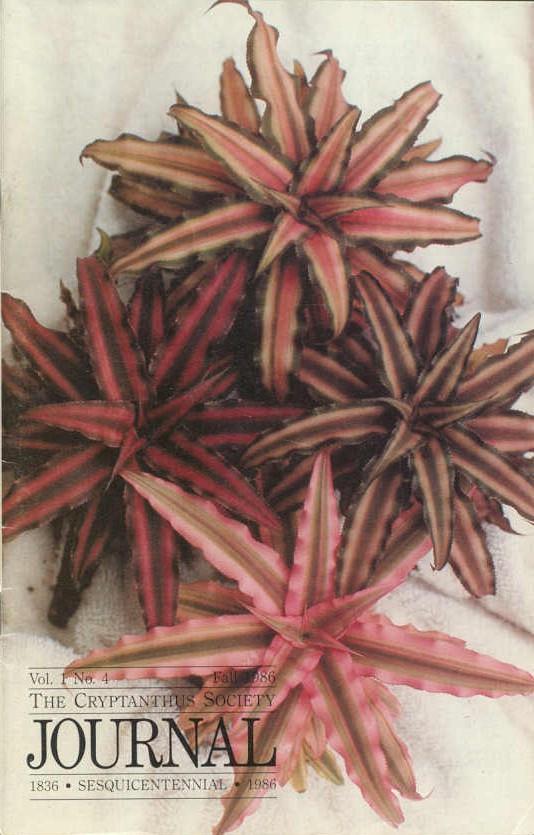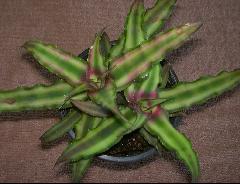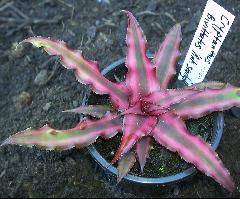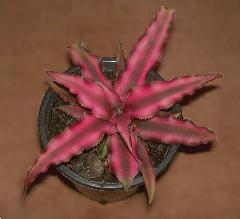
Starlite
Ruby - - - - - - bivittatus
Pink Starlite
Click www.fcbs.org/csj/index.html to see more of the Cryptanthus Society Journals.
Article 09/06 : Cryptanthus Ruby.
By Ian Hook.
Greetings fellow members from your amateur webmaster, and definitely amateur Bromeliad grower.
One of my first prize possesions was a Cryptanthus labelled “Pink Starlight” I purchased at the BSA Autumn Show in 2004.
Since that time I have been guilty of growing its pups and spreading this wrongly named (and spelt) plant even further !
With the help of some experts, I have been set right and would like to pass on what I have learnt.
Firstly, I was introduced to Geoff Lawn, in a welcome he gave to the new “Cryptanthus group at Yahoo! Groups, a free, easy-to-use email group service.”
Hello Cryptanthus Growers, I live in Perth , Western Australia and have grown bromeliads including Cryptanthus for over 30 years. I joined the Cryptanthus Society in 1987 and have been a continuous member ever since.
In 2002 I became the Cryptanthus Society's International Director. I maintain the Cryptanthus Society's Master Lists of species and cultivars plus numbered plants from wild-collected specimens or botanical institution's acquired specimens which have an allocated number which is referenced when the specimen is identified.
Perth, at 32 degrees latitude south on the west coast facing the Indian Ocean, has a Mediterranean climate--hot dry Summers with low humidity, plus cool to cold wet Winters, which can prove quite a challenge in growing Cryptanthus well.
Hopefully at this grass roots level we can all benefit by sharing our knowledge and experience, plus tackle those "simple" problems or queries which often require detailed answers.
Regards, Geoff Lawn.
While chatting to Geoff we quickly turned to our mutual dislike of the American spelling of the registered name, “Pink Starlite”. It seems I am not alone in this, and I have seen the ENGLISH spelling used several times since. It was even used in the Cryptanthus Society Journal, which must have equally raised some American eyebrows !
I suspect Geoff is going to take this argument further with Derek Butcher – “Good Luck”!
….. the spelling--it is officially C. 'Pink Starlite'. Originally it was spelt incorrectly as C. 'Pink Starlight' in the Crypt. Soc. Journal featuring C bivittatus var. bivittatus and several of its cultivars--see attached photo of CSJ. vol. 1 no. 4 (1986) front cover photo. So the misspelling stuck with me.
Top specimen is C. 'Starlite' (now very rare or non-existent), which sported from C. 'Pink Starlite'. Clockwise is C. bivittatus var. bivittatus, then C. 'Pink Starlite', then C. bivittatus 'Ruby'.

Click www.fcbs.org/csj/index.html to see more of the Cryptanthus Society Journals.
What separates 'Ruby' from 'Pink Starlite' you ask ? If you study the foliage in detail, It's both seasonal colour and stripes pattern.
'Pink Starlite' is consistently marginated candy pink or flesh pink, in poorer light the pink edges become creamy white, NEVER green. The ONE central olive green stripe tends to be pale. In other words, 'Pink Starlite" really has only 3 large stripes per leaf but sometimes thin striations centrally.
'Ruby' is NEVER albo-marginated---the edge stripe is either green in poor light or dark olive green in high light--same as it's central stripe. Both sides of the central stripe are a stripe of rich ruby red in high light, verging on BRIGHT pink--which go cream or creamy green in low light. Each leaf consistently has 5 stripes, and rarely any striations.
I think ALL the fcbs.org/ photos of 'Pink Starlite' and 'Ruby' are correctly named----and they are species cultivars, NOT hybrids. It has been theorised that 'Ruby' is really C. bivittatus var. atropurpureus (never found in the wild since it's original description) but Harry Luther considers all bivittatus types are from one clone, with only a red gene separating them, so varietal status is not really warranted. The same is true for C. bivittatus var. bivittatus ---- never refound in the wild -- probably it's localised habitat has been destroyed.
Bird Rock Tropicals' photo of 'Ruby' on fcbs is not typical colour, but Pamela Koide's conditions give MANY of her Crypts this bright pink colouration. Your extreme left BSA Website photo of so-called 'Pink Starlite' is exactly how my correctly-named 'Ruby' looks in Winter---lots of green with a few minor specks or splotches of red.
These are the sequential pictures (formerly) on the BSA website as Pink Starlite” that triggered this correction.



